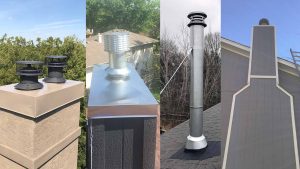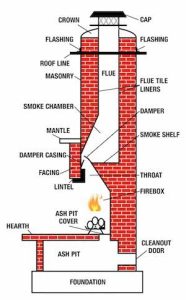

Chimneys in Eastern Ontario Homes
Chimneys are an architectural and functional feature that continue to define many homes in Eastern Ontario. From historic brick farmhouses in Hastings County to stately Victorian homes in Belleville or Kingston, chimneys often serve as both a practical venting system and a visual marker of the home’s character. Even in modern builds, where wood-burning fireplaces are less common, chimneys remain relevant—sometimes venting gas or oil furnaces, or incorporated as design statements with exterior stone or brickwork.
Common Chimney Materials
The traditional material for chimneys in Eastern Ontario is brick masonry, chosen for its durability, fire resistance, and timeless aesthetic. Many older homes feature handmade clay bricks with lime-based mortar, while modern builds use machine-made brick or stone veneers. Stone chimneys are also common, especially in rural cottages and country homes, often crafted from local limestone or fieldstone to reflect the natural landscape. In more recent decades, prefabricated metal chimneys (often stainless steel) have become widespread for woodstoves, pellet stoves, and high-efficiency appliances—offering lighter weight, easier installation, and compliance with updated building codes.
The Parts of a Chimney
A properly built chimney is made up of multiple components, each serving an important role in performance and safety:
-
Chimney Flue: The vertical passage inside the chimney that carries smoke, gases, and combustion byproducts safely out of the home. It may be lined with clay tile, stainless steel, or concrete to resist heat and corrosion.
-
Flue Liner: Installed inside the flue to protect the masonry from heat and acidic exhaust. Modern codes in Ontario typically require liners for efficiency and safety.
-
Smoke Chamber: Located just above the fireplace firebox, this chamber funnels smoke smoothly into the flue. Its sloped walls help prevent turbulence and backdrafts.
-
Chimney Crown/Cap: The concrete or stone slab at the very top of the chimney, sloped to shed water. A chimney cap (often metal with a screen) is added to prevent rain, snow, debris, and animals from entering.
-
Chimney Stack: The visible part of the chimney that extends above the roofline, exposed to weather and defining the home’s exterior look.
-
Flashing: Metal (often aluminum or copper) installed where the chimney meets the roof to prevent leaks. Proper flashing is critical in Ontario’s freeze-thaw climate.
-
Thimble/Chimney Connector: In systems with woodstoves or furnaces, this is the entry point that connects the appliance pipe to the chimney flue.
-
Cleanout Door: Usually located at the base of the chimney, allowing easy access for sweeping out ash and soot.
Chimney Styles and Aesthetics
Chimneys in Eastern Ontario vary widely depending on age and design. Single-flue chimneys are most common, while multi-flue chimneys (serving multiple fireplaces or appliances) are often seen in larger or heritage homes. Exposed brick stacks with corbelled detailing (projecting brickwork near the top) add historic charm, while stone chimneys give rustic cottages a natural, grounded look. Modern homes often opt for a slimmer metal chimney for practical venting, sometimes enclosed in a chase clad with siding, stone, or stucco to integrate with the home’s design.
Climate and Maintenance Considerations
Eastern Ontario’s harsh winters place heavy demands on chimneys. Moisture intrusion, combined with freeze-thaw cycles, can cause bricks and mortar to crack or spall. Proper crowns, caps, and flashing are essential for longevity. Annual inspections and cleanings are strongly recommended, especially for wood-burning systems, to prevent creosote buildup and chimney fires. Many homeowners also retrofit older chimneys with stainless steel liners, which improve draft, efficiency, and safety while extending the life of the chimney.

